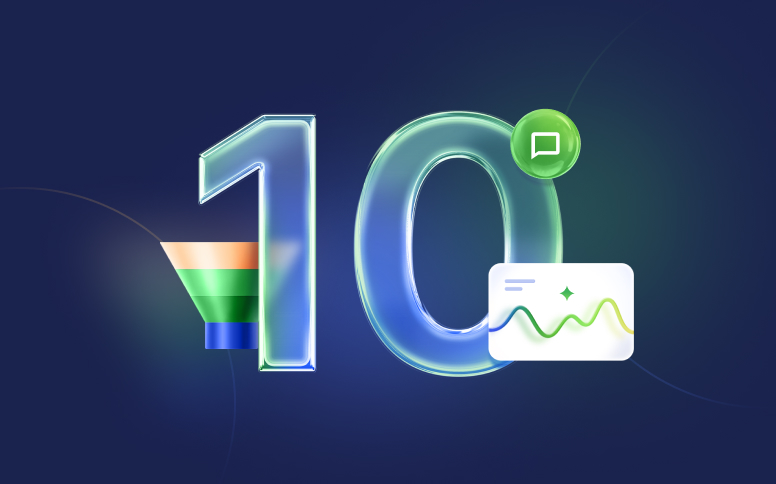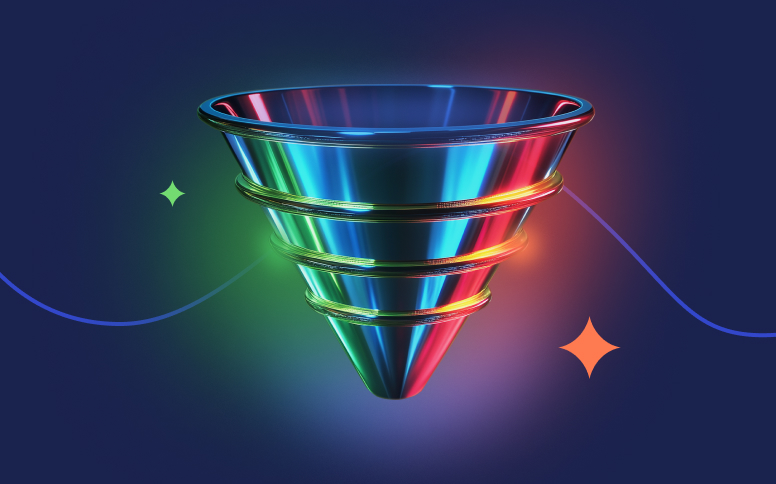Top 6 Prospecting Tools Every Sales Team Should Know
That said, having a strong lead generation strategy isn’t enough on its own. Your team still needs to identify which potential customers are actually worth pursuing.
Not every lead will turn into a customer. Trying to treat them all the same just wastes time and resources. That’s why it’s important to have a clear prospecting process in place—something that helps your team focus on the potential buyers that are most likely to move forward.
In this article, we’ll walk through some of the top prospecting software to consider in 2025. Each one works a little differently, but the goal is the same: help your team work smarter, not harder.
What is the Sales Prospecting Process?
Finding prospects isn’t easy. Doing it manually takes time—usually more than most teams can spare.
That’s where software helps. Tools that let you search, sort, and filter leads can take a lot of the manual work off your plate. They won’t do the thinking for you, but they can speed things up.
So what exactly is sales prospecting?
In simple terms, it’s the sales process of figuring out who might be interested in what you offer—and then reaching out. It usually breaks down into three steps.
Step #1: Research
Start by collecting useful information about your leads. This could mean scanning their website, checking out their social media, or looking through their LinkedIn profile. The more you know, the better you can decide if they’re a good fit.
Step #2: Qualification
Next, sort your potential buyers. Some will be a better match than others. Maybe they’ve shown clear interest. Maybe they fit your ideal client profile. Focus on the ones that matter most.
Step #3: Outreach
Now it’s time to get in touch. You might write a short message or pick up the phone. Either way, the goal is the same: start a real conversation.
4 Benefits of Lead Prospecting Tools
#1: Improve Efficiency
One of the biggest advantages of using such tools is how much time they save. Instead of digging through scattered data, you can pull everything you need in one place and hand it off to your sales team without delay.
That data might include things like website activity, company size, purchase history, contact info, and more. It’s all there—ready to help your team make faster, better decisions.
#2: Get Better Leads
The best outreach platforms help you get better-quality leads every time. The truth is, you might be talking to someone who doesn’t have decision-making power or someone who doesn’t have the budget for your service or product. A good prospecting platform helps prevent this by letting you qualify potential clients more effectively.
#3: Get More Leads
When you’re using B2B software, you’ll access more leads—and might even uncover hidden opportunities. On top of that, it becomes much easier to find the information you need about each prospect.
#4: Stay Compliant
No one wants legal trouble. A solid sales tool helps you stick to data privacy rules like GDPR and other regulations. It makes it easier to keep your outreach on the right side of the law—without slowing you down.
B2B Prospecting Tools: 4 Different Types
No matter which type of software you use, the goal’s the same: find good leads, figure out which ones are worth your time, collect the right info, and reach out—by phone, email, text, or whatever works best.
With that said, here are the four main types of top prospecting tools:
#1: CRM Systems
CRM systems are the first type of sales prospecting tool. Also known as Customer Relationship Management systems, these platforms give you detailed information about each customer. This includes their contact details, purchase history, best times to reach them, and more.
One of the best things about using this type of sales solution is that most CRMs already include AI features and integrations—helping you manage and run your business more efficiently.
Overall, this kind of tool gives you a clear view of your potential clients, allowing you to focus only on the most promising ones and save valuable time.
#2: Sales Intelligence Tools
Sales intelligence software provides more direct insights into your sales efforts and how your team can improve. These tools often include access to B2B company databases and use specific triggers to alert your team when it’s the right time to contact a lead.
Some common triggers include:
- Buyer intent data
- Changes in ownership
- Updates in company processes or applications
- New job roles
- Recent fundraising activity
#3: Sales Engagement Platforms
These platforms are often confused with CRM systems, as both help align sales and marketing teams when targeting prospects. In fact, many CRM systems now include sales engagement features such as:
- Reports
- Scheduling daily activities
- Data analysis
- Outreach based on the prospect’s preferred contact method
#4: Email Outreach & Automation Tools
Once you’ve researched and prioritized your leads, it’s time to reach out—and that’s where this software comes in. Email automation can save you a lot of time. Just make sure your messages still feel personal—automated doesn’t have to mean generic.
6 Best Sales Prospecting Software
#1: Flowlu: A Complete Prospecting Tool Built Into Your CRM
If you need a sales prospecting tool that goes beyond storing contacts, Flowlu is worth checking out. It’s a cloud-based CRM that helps you find, sort, and manage potential buyers—all in one spot.
Flowlu isn’t just another CRM. It works as a powerful tool that helps you:
- Search and filter your lead database with custom fields
- Score and tag potential clients based on key criteria
- Avoid duplicate outreach with built-in duplication control
- Assign leads and make CRM records visible only to their owners for full privacy
You can also connect Flowlu to email, telephony, WhatsApp, Viber, Telegram, and even LinkedIn (via Make, Pabbly, or other third-party connectors) to reach potential clients across multiple channels—without switching tools.
Once you’ve got your leads in, Flowlu lets you build out your sales pipeline with automated workflows, schedule follow-ups, and track progress with reports and dashboards. Everything’s organized, accessible to your team, and incredibly easy to use—even if you’ve never touched a CRM before.
And yes, there's a free trial. So you can explore the tools, tweak your setup, and see how it fits—before committing to a plan. Flowlu’s pricing starts at $39/month for a team of up to 8 users, with a flat fee that keeps things simple and budget-friendly.
#2: HubSpot: B2B Prospecting with Built-In AI and Marketing Tools
When you’re looking for the best B2B sales prospecting software, HubSpot is definitely worth considering. After all, it’s one of the most well-known platforms out there.
Overall, HubSpot is a CRM that already incorporates AI. This means that, from one central place, you can manage your service, sales, and marketing tools—making your work a whole lot easier. You can use this automated prospecting system not only to attract new leads to your business but also to close deals and support your existing customers.
There’s no question that HubSpot is a very complete app that can be incredibly helpful. In terms of pricing, you can start with the free CRM, then choose from multiple plans based on your needs. Paid plans start at $20/month per user. You also have the option to add extra features through paid add-ons.
#3: 6Sense: AI Prospecting Tools That Find Anonymous Intent
6Sense is another great option to consider when searching for the best sales software.
This AI-driven platform works a bit differently from the other tools mentioned in this list. According to the company, 6Sense focuses on the “Dark Funnel”—the stage where buyers conduct research anonymously before reaching out. What these buyers don’t realize is that they leave behind valuable sales data, which 6Sense can track and collect.
It pulls data from places like industry news sites, blogs, social platforms, and review pages. Once you’ve got that information, you can use it to build sales lead lists and set up workflows that actually match how your team works.
It’s worth noting that 6Sense’s interface can be a bit complex, especially when compared to some of the other tools in this article. Pricing: 6Sense offers a free plan with 50 credits per month, which is a good starting point for individuals or small teams. Paid plans are custom-priced based on your business size and goals. For larger companies, enterprise pricing reportedly starts around $120,000 per year—and usually comes with a two-year commitment.
#4: Dealfront: B2B Prospecting with Deep Filters
If you’ve been looking into B2B prospecting tools, Dealfront might not be on your radar yet. The name’s new, but the tool isn’t—it was formed through a merger between Echobot and the Finnish company Leadfeeder. And if neither of those rings a bell, here’s what you should know: Dealfront has one of the largest B2B databases available.
You can think of Dealfront as a sales intelligence solution that allows you to search for top prospects using more than 100 available filters. These include not only common filters like financials and geography but also more specific ones such as keywords and trigger events.
One thing we like about Dealfront is its wide range of integrations and its multilingual AI-powered web crawling capabilities. Pricing starts at €99 per month, with custom plans available based on your business needs.
#5: Cognism: Global Prospecting with Verified Contact Numbers
Cognism is considered by many to be the ultimate B2B sales tool—and that’s largely thanks to its massive database. It includes contact numbers across multiple regions, including APAC, NAM, and EMEA.
Cognism gives you more than just access to global data. You can build your own lead lists and connect everything directly to your CRM.
If your team needs cleaner data, there’s also a premium option. It includes Diamond-verified contacts—phone numbers that are checked and up to date. That means fewer dead ends and less time wasted.
Cognism works as both a browser extension and a web app, so it fits easily into most setups. Cognism offers customized pricing based on factors like company size, number of users, and specific feature requirements. While exact figures aren't publicly disclosed, reports suggest that annual costs can range from approximately $15,100 to over $100,000.
#6: LinkedIn: Prospecting Built into the World’s Top Business Network
Well, we have no doubt you’ve heard of LinkedIn. After all, it's the number one social network focused on businesses and professionals. It makes sense that LinkedIn uses its massive database for prospecting.
The tool is called LinkedIn Sales Navigator. It comes in three versions: Core, Advanced, and Advanced Plus. Each one is built for different setups—individual reps, teams, or larger companies.
All plans include lead suggestions and advanced filters. The main difference is in the extras you get at each level.
One thing to keep in mind: you’re limited to 50 direct messages a month, no matter which plan you’re on. That cap might feel tight for some businesses. Pricing starts at $99.99 per month for the Core plan.
Bottom Line
Finding top sales prospecting tools isn’t difficult. In fact, there are plenty of online apps out there to help you generate more potential customers for your business.
But if you’re looking for a solution that goes beyond lead generation, consider Flowlu. In addition to being a strong lead prospecting solution, it’s a cloud-based CRM that helps you manage your entire business—regardless of size or industry.
Simply put, it’s a sales-focused software or app designed not only to identify potential buyers (leads or prospects) but also to help you reach them and convert them into customers.
Prospecting data is exactly what it sounds like—information about leads that helps with sales and marketing. It can include things like contact details, financials, company size, purchase history, or even how someone interacts with your site. You might also see patterns in preferences or behavior over time.
Sales prospecting websites come with built-in tools that help you work faster and stay organized. Many offer things like email automation, task tracking, CRM integration, and reporting—with flexible pricing to match different team sizes and needs.
Some go a step further and let you filter prospects in real time based on things like revenue potential. That makes it easier to spot high-value potential buyers and decide who to reach out to first.
















